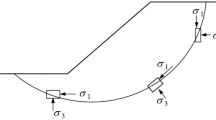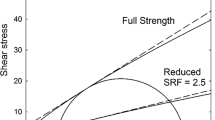Abstract
Conventional geotechnical software limits the use of the strength reduction method (SRM) based on the Mohr–Coulomb failure criterion to analyze the slope safety factor (SF). The use of this constitutive model is impractical for predicting the behavior of all soil types. In the present study, an innovative numerical technique based on SRM was developed to determine SF using the finite element method and considering the extended Cam–clay constitutive model for clayey gravel soil as opposed to the Mohr–Coulomb model. In this regard, a novel user subroutine code was employed in ABAQUS to reduce the stabilizing forces to determine the failure surfaces and resist and drive shear stresses on a slope. After validating the proposed technique, it was employed to investigate the performance of terraced slopes in the context of a case study. The impacts of geometric parameters and different water table elevations on the SF were examined. The results indicated that an increase in the upper and lower slope heights led to a decrease in SF, and a slight increase in the horizontal offset led to an increase in the SF. Moreover, when the water table elevation was lower than the toe of the terraced slope, the SF increased because of the increase in the uplift force as a resistant component.
Similar content being viewed by others
References
Camera C, Apuani T, Masetti M. Modeling the stability of terraced slopes: An approach from Valtellina (Northern Italy). Environmental Earth Sciences, 2015, 74(1): 855–868
Cheng Y M, Lansivaara T, Wei W B. Two-dimensional slope stability analysis by limit equilibrium and strength reduction methods. Computers and Geotechnics, 2007, 34(3): 137–150
Bojorque J, de Roeck G, Maertens J. Comments on ‘Two-dimensional slope stability analysis by limit equilibrium and strength reduction methods’ by Y.M. Cheng, T. Länsivaara and W.B. Wei [Computers and Geotechnics 34 (2007) 137–150]. Computers and Geotechnics, 2008, 35(2): 305–308
Xu Q, Yin H, Cao X, Li Z. A temperature-driven strength reduction method for slope stability analysis. Mechanics Research Communications, 2009, 36(2): 224–231
Zhao L, Xia P, Xie R, Li L, Zhang Y, Cheng X. Stability analysis of homogeneous slopes with benches. Geomechanics and Engineering, 2017, 13(3): 517–533
Zhao L, Yang F, Zhang Y, Dan H, Liu W. Effects of shear strength reduction strategies on safety factor of homogeneous slope based on a general nonlinear failure criterion. Computers and Geotechnics, 2015, 63: 215–228
Zhang Y, Xiang C, Yu P, Zhao L, Zhao J X, Fu H. Investigation of permanent displacements of near-fault seismic slopes by a general sliding block model. Landslides, 2022, 19(1): 187–197
Zhang Y, Xiang C, Fu H, Liu J, Cheng Y. Effect of excitation-applied manners on permanent displacements of planar slopes using dynamic sliding blocks analysis. International Journal of Geomechanics, 2022, 22(5): 04022042
Zhang Y, Chen G, Zheng L, Li Y, Zhuang X. Effects of geometries on three-dimensional slope stability. Canadian Geotechnical Journal, 2013, 50(3): 233–249
Zhang Y, Chen G, Wang B, Li L. An analytical method to evaluate the effect of a turning corner on 3D slope stability. Computers and Geotechnics, 2013, 53: 40–45
Michalowski R L. Stability of intact slopes with tensile strength cut-off. Geotechnique, 2017, 67(8): 720–727
Zhao L H, Cheng X, Zhang Y, Li L, Li D J. Stability analysis of seismic slopes with cracks. Computers and Geotechnics, 2016, 77: 77–90
Li Z W, Yang X L, Li T Z. Static and seismic stability assessment of 3D slopes with cracks. Engineering Geology, 2020, 265: 105450
Yang X L, Zhang S. Stability analysis of 3D cracked slope reinforced with piles. Computers and Geotechnics, 2020, 122: 103544
Zhang Y B, Liu Y, Yuan R, He Y. Comparison of seismic stability for slopes with tensile strength cut-off and cracks. Journal of Mountain Science, 2021, 18(12): 3336–3347
Brinkgreve R B. Selection of soil models and parameters for geotechnical engineering application. In: Proceedings of Geo-Frontiers Congress. Austin: ASCE, 2005, 69–98
Lade P V. Overview of constitutive models for soils. In: Proceedings of Geo-Frontiers Congress. Austin: ASCE, 2005, 1–34
Taborda D M, Pedro A M, Pirrone A I. A state parameter-dependent constitutive model for sands based on the Mohr–Coulomb failure criterion. Computers and Geotechnics, 2022, 148: 104811
Basack S, Karami M, Karakouzian M. Pile-soil interaction under cyclic lateral load in loose sand: Experimental and numerical evaluations. Soil Dynamics and Earthquake Engineering, 2022, 162: 107439
Potts D M, Zdravković L, Addenbrooke T I, Higgins K G, Kovačević N. Finite Element Analysis in Geotechnical Engineering: Application. London: Thomas Telford, 2001
Borja R I. Cam–clay plasticity, Part II: Implicit integration of constitutive equation based on a nonlinear elastic stress predictor. Computer Methods in Applied Mechanics and Engineering, 1991, 88(2): 225–240
Dassault Systemes. Theory Manual for ABAQUS Version 6.12–3
Schofield A N, Wroth P. Critical State Soil Mechanics. London: McGraw-Hill, 1968
Parry R H G. Stress–Strain Behaviour of Soils. England: G. T. Foulis & Co., 1972
Helwany S. Applied Soil Mechanics with ABAQUS Applications. New Jersey: John Wiley & Sons, 2007
Resende L, Martin J B. Formulation of Drucker–Prager cap model. Journal of Engineering Mechanics, 1985, 111(7): 855–881
Chen W F, Han D J. Plasticity for Structural Engineers. New York: Springer, 1988
D2435/D2435M-11. Standard Test Methods for One-Dimensional Consolidation Properties of Soils Using Incremental Loading. West Conshohocken: ASTM, 2011
D7181-11. Method for Consolidated Drained Triaxial Compression Test for Soils. West Conshohocken: ASTM, 2011
Potts D M, Zdravkovic L. Accounting for partial material factors in numerical analysis. Geotechnique, 2012, 62(12): 1053–1065
Karami M, Kabiri-Samani A, Nazari-Sharabian M, Karakouzian M. Investigating the effects of transient flow in concrete-lined pressure tunnels, and developing a new analytical formula for pressure wave velocity. Tunnelling and Underground Space Technology, 2019, 91: 102992
Karakouzian M, Karami M, Nazari-Sharabian M, Ahmad S. Flow-induced stresses and displacements in jointed concrete pipes installed by pipe jacking method. Fluids, 2019, 4(1): 34
Karakouzian M, Nazari-Sharabian M, Karami M. Effect of overburden height on hydraulic fracturing of concrete-lined pressure tunnels excavated in intact rock: A numerical study. Fluids, 2019, 4(2): 112
Liu Y, He Z, Li B, Yang Q. Slope stability analysis based on a multigrid method using a nonlinear 3D finite element model. Frontiers of Structural and Civil Engineering, 2013, 7(1): 24–31
Lian J, Wu J. Surficial stability analysis of soil slope under seepage based on a novel failure mode. Frontiers of Structural and Civil Engineering, 2021, 15(3): 712–726
Belandria N, Úcar R, León F M, Hassani F. Stability analysis of slopes with planar failure using variational calculus and numerical methods. Frontiers of Structural and Civil Engineering, 2020, 14(5): 1262–1273
Author information
Authors and Affiliations
Corresponding author
Rights and permissions
About this article
Cite this article
Karami, M., Nazari-Sharabian, M., Bristow, J. et al. Evaluation of the stability of terraced slopes in clayey gravel soil using a novel numerical technique. Front. Struct. Civ. Eng. 17, 796–811 (2023). https://doi.org/10.1007/s11709-023-0922-9
Received:
Accepted:
Published:
Issue Date:
DOI: https://doi.org/10.1007/s11709-023-0922-9




